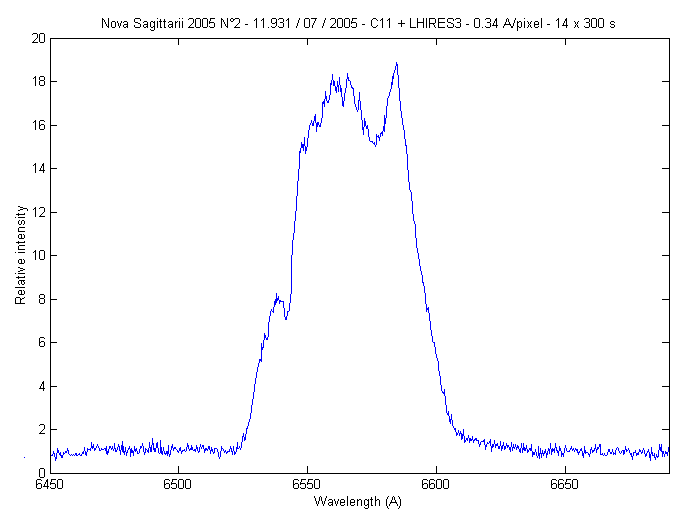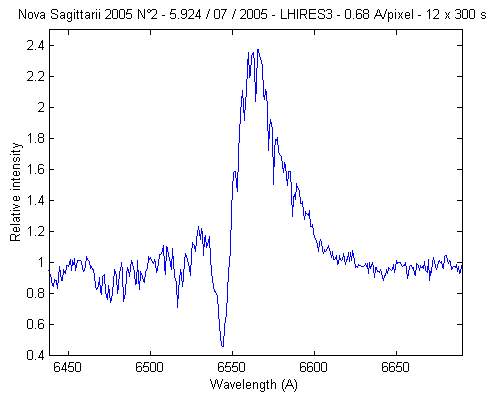NOVA
SAGITTARII 2005 N°2 (V5116 Sgr)
Discovered by
W. Liller, Vina del Mar, Chile at magnitude approximately 8.0 on two
red photographs taken on July 4.049 UT (85-mm camera lens + Technical
Pan film + deep orange filter). See IAUC 8559.
Position: R.A. = 18h17m50s.77, Decl.
= -30o26'31".2 (equinox 2000.0)
July 5.9 UT 2005 Observation (at V magnitude near 8.2)
Observatory: Castanet Tolosan (France)
- IAU959
Observer: Christian Buil
Instrument: Celestron
11 telescope (0.28 m diameter) -LHIRES3
spectrograph equiped with a 1200 g/mm grat (sampling of 0.34 A/pixel and 0.68
A/pixel) + Audine KAF-0401E CCD

View
of the setup during nova Sagittarii no 2 observation. The LHIRES3 spectrograph
is at the f/10 focus of the 0.28 m telescope. The nova is a very
southern objet for my observatory location !
Two spectra are successively acquired
with different spectral sampling:

2D
spectrum taken with a spectral sampling of 0.68 A/pixel (bin 2x2) - Sum of 12
images exposed 300 seconds each (cumulative exposure time of 3600 seconds).

2D
spectrum taken with a spectral sampling of 0.34 A/pixel (bin 1x1) - Sum of 14
images exposed 300 seconds each (cumulative exposure time of 4200 seconds).
The spectrum of nova Sagittarii in the Ha
region (0.68 A/pixel run). The spectral responsivity of the system is evaluated
from standard star observations and corrected. The continuum curvature is removed
and the continuum is normalized to unity. The left curve show the H2O telluric
lines. For the right curve, the telluric line are removed. VisualSpec processing.
The spectrum of nova Sagittarii in the Ha
region (0.34 A/pixel run). The spectral responsivity of the system is evaluated
from standard star observations and corrected. The continuum curvature is removed
and the continuum is normalized to unity. The left curve show the H2O telluric
lines. For the right curve, the telluric line are removed. VisualSpec processing.

Comparison
of spectra taken during the two runs. Notice the consistency of the continuum
features, but also a possible short term evolution of Ha line.
Download
ASCII spectra - run #1 (050705_1.DAT)
Download
ASCII spectra - run #2 (050705_2.DAT)
The
Ha
measured peak intensity is 2.3 time the nearby continuum level the 5.95/07
UT. The FWHM of
this line is 1230 km/sec +/- 50 km/sec. The FWZI (Full Width at Zero Intensity)
of Ha
is 4200
km/sec +/-150 km/sec.
July 10.9 UT 2005 Observation
(V=9.5)
Observatory: Castanet Tolosan (France)
- IAU959
Observer: Christian Buil
Instrument: Celestron
11 telescope (0.28 m diameter) -LHIRES3
spectrograph equiped with a 2400 g/mm grat (sampling of 0.115 A/pixel) + Audine KAF-0401E CCD

Download
ASCII spectra (100705.DAT)
July 11.9 UT 2005 Observation (V=9.5)
Observatory: Castanet Tolosan (France)
- IAU959
Observer: Christian Buil
Instrument: Celestron
11 telescope (0.28 m diameter) -LHIRES3
spectrograph equiped with a 1200 g/mm grat (sampling of 0.34 A/pixel) + Audine KAF-0401E CCD

Download
ASCII spectra (110705.DAT)
July 13.01 UT 2005 Observation (V=9.5)
Observatory: Castanet Tolosan (France)
- IAU959
Observer: Christian Buil
Instrument: Celestron
11 telescope (0.28 m diameter) -LHIRES3
spectrograph equiped with a 1200 g/mm grat (sampling of 0.34 A/pixel) + Audine KAF-0401E CCD

Download
ASCII spectra (120705.DAT)
Time evolution

See also low resolution spectrum
taken by Olivier Thizy 5
July.
Back
the novae page











